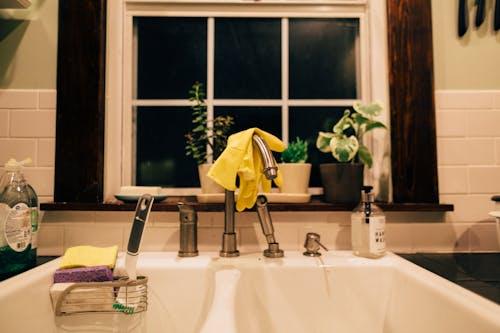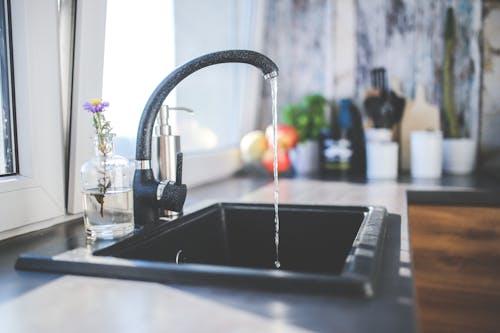
A kitchen sink is more than just a place to wash dishes—it’s a cornerstone of your kitchen’s design and functionality. From prepping meals to cleaning up, it’s a tool you’ll use daily, so choosing the right one matters. With so many types, styles, and materials available, understanding your options can feel overwhelming. In this article, we’ll break it all down to help you decide what works best for your space and lifestyle.
Different Types of Kitchen Sinks

Kitchen sinks (see more here) come in a variety of styles to match different needs and kitchen designs. Let’s break down the most common types.
Single-Basin Sinks
If you tend to wash large pots or pans, a single-basin sink might suit you. The single, uninterrupted space offers plenty of room for oversized items. However, it doesn’t allow for separating tasks like rinsing and washing at the same time.
Double-Basin Sinks
These are popular for multitasking. They have two compartments, often of different sizes, allowing you to wash dishes in one side and rinse in the other. If you use a dishwasher most of the time, the extra basin isn’t always necessary.
Farmhouse Sinks
Farmhouse sinks, also called apron-front sinks, are known for their distinct design. With a deep basin and a front-facing panel, they’re great for heavy-duty tasks. They fit best with traditional or country-style kitchens.
Undermount Sinks
Undermount sinks attach beneath the countertop for a seamless, clean look. Without exposed edges, cleaning crumbs and spills into the sink is much easier. Just note that they’re often pricier to install.
Top-Mount Sinks
Also called drop-in sinks, these are installed by placing the sink into a cutout in the countertop. The edges of the sink rest on top, which makes installation easier and cheaper. They work with most countertop materials.
Materials Used for Kitchen Sinks
When choosing from a wide range of kitchen sinks, the material matters just as much as the style or shape. Different materials bring unique benefits to the table, whether you prioritize durability, maintenance, or design. Let’s explore the most popular options.
Stainless Steel
Stainless steel is a top choice for many kitchens—and for good reason. Its durability makes it perfect for busy households, while its timeless look complements nearly any design.
- Highly durable: Resists dents, heat, and corrosion, holding up against heavy use.
- Easy maintenance: A quick wipe with soapy water keeps it clean. It also resists stains and odors.
- Versatility in finishes: Options range from shiny polished surfaces to brushed or matte ones that hide water spots and scratches better.
The downside? It can be a little noisy, but many models now come with sound-dampening pads to reduce clatter.
Composite Materials
Composite sinks, often made from a blend of materials like quartz or granite and resin, are a sleek option that balances durability and style.
- Scratch and stain resistance: Hard surfaces fend off marks and discoloration better than many other materials.
- Color variety: Available in a range of tones, they can match or contrast beautifully with your countertop.
- Durable yet stylish: They offer a modern aesthetic that’s built to handle abuse without losing their charm.
While they’re tough, avoid harsh cleaners to keep them looking fresh and damage-free.
Ceramic and Porcelain
For a more traditional or vintage vibe, ceramic and porcelain sinks are a go-to option. They blend elegance with practicality, making them a fixture in timeless kitchen designs.
Here’s why they remain a classic:
- Effortless to clean: Their smooth, glossy surface repels grime, making upkeep a breeze.
- Charming look: Whether your kitchen is modern or farmhouse-inspired, their finish adds undeniable character.
- Decently durable: While strong, they can chip or crack if you drop something heavy, so handle with care.
These sinks work beautifully in kitchens focused on aesthetics but may require a little extra caution during daily use.
Granite and Stone
If you’re aiming for a high-end feel, granite and stone sinks might be just what you’re looking for. These materials combine durability with a luxurious, natural appearance.
- Unmatched durability: Resistant to scratches, heat, and heavy impacts, ideal for long-lasting performance.
- Unique texture: Each sink boasts a one-of-a-kind appearance, thanks to natural stone variations.
- Low noise: The stone structure naturally dampens sounds, making dishwashing a quieter task.
These sinks do require more maintenance, though. Sealing them regularly helps prevent stains and keeps them looking pristine.
Cast Iron Sinks
Cast iron sinks have been around for decades, and their longevity speaks volumes about their quality. Coated with a glossy enamel, they blend toughness with a polished finish.
- Incredible durability: Built to last decades, withstanding heavy use without cracking or warping.
- Enamel finish: Provides a shiny, smooth surface that resists stains and adds a vintage or classic vibe.
- Heat tolerance: Easily handles hot pots and pans without damage.
However, these sinks are heavy, so ensure your countertop and cabinetry can support the weight. Over time, the enamel can wear, but with proper care, they can last a lifetime.
Think You’re in Need of an Upgrade?
If your current sink doesn’t meet your needs, it might be time for an upgrade. Think about what bothers you—too small? Too shallow? Hard to clean? Upgrading can make daily tasks easier and improve your kitchen’s overall look.
Don’t forget to match your sink choice with the overall kitchen design. A modern kitchen may look best with an undermount stainless steel sink, while a farmhouse kitchen might need a large, deep apron-front sink.
Some Maintenance Tips
Learn more at this site: https://www.marthastewart.com/how-to-clean-kitchen-sink-and-drain-8418600
Your sink sees a lot of action, so keeping it in good shape requires a little effort. Here’s how to maintain different materials:
- Stainless Steel: Use a soft cloth and mild cleaner to avoid scratches. Avoid abrasive pads.
- Cast Iron: Don’t drag heavy pans across the enamel surface. Clean with non-acidic products.
- Granite Composite: Avoid strong chemicals. Wipe up spills to prevent stains.
Conclusion

The kitchen sink is more than just a workspace – it’s a key design element and a daily essential. Understanding your options can help you pick a sink that fits your lifestyle and complements your kitchen. Look at the shape, material, and installation style that suits your space best. With the right sink, even washing dishes might feel a little less like a chore.
